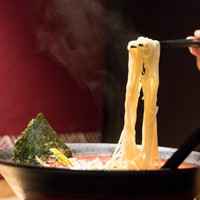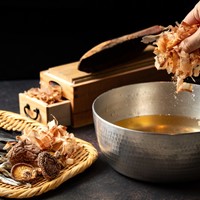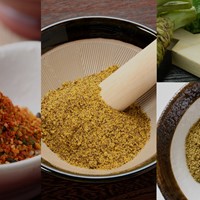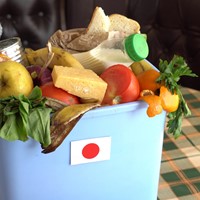Japanese Oden: Rich History & Regional Variations

This page contains affiliate links.
Japanese Oden is a beloved dish with a rich history and intriguing regional variations. The Japanese have enjoyed this comforting and flavorful stew-like dish for centuries. Let's look at what makes Japanese Oden unique, from its traditional ingredients to its fascinating evolution through different eras of Japanese history.
What is Japanese Oden?
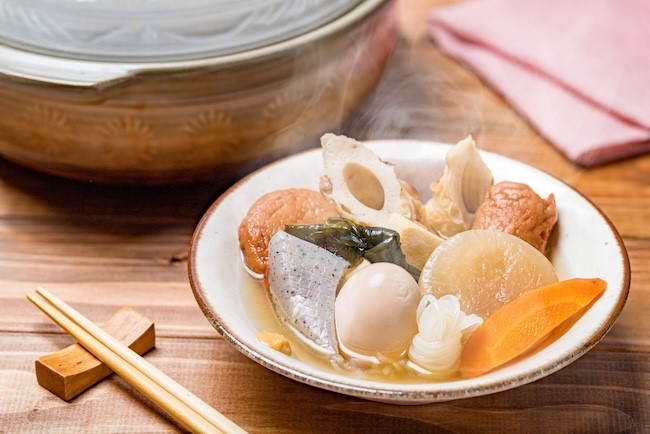
Oden is a hotpot-style dish with various ingredients simmered in a soy-based broth. The ingredients could be anything from tofu and daikon radish to fish cakes and boiled eggs. The beauty of Oden lies in its simplicity and the way it brings different flavors together in a harmonious and comforting way.
Traditionally, Oden is enjoyed during the colder seasons, particularly in autumn and winter, when people seek comfort in warm and hearty dishes. It is commonly found in street food stalls, izakayas (Japanese pubs), and convenience stores throughout Japan. When it comes to enjoying it, there are no strict rules. Some prefer to eat it as a standalone dish, savoring each ingredient individually. Others like to dip the ingredients in a small dollop of karashi (Japanese mustard) or ponzu sauce (a citrus-based sauce) for an extra kick of flavor.
The History & Evolving Narrative of Japanese Oden
Oden's tale begins in the Heian Period (794-1185), emerging as 'misodengaku,' a simple soup with skewered tofu and vegetables simmered in miso. Fast forward to the Edo Period (1603-1868), Oden morphed closer to today's version, its name derived from "dengaku." Its broth shifted to soy-based, particularly in the Kanto region, becoming a popular street food offering.
The Meiji Era (1868-1912) saw Japan opening to Western influences, with Oden integrating new, foreign ingredients, diversifying its palate, and spawning regional variants. Post-war Showa Era (1926-1989) spotlighted convenience with the advent of convenience stores, making oden a staple and introducing oden cans for on-the-go comfort.
The Heisei Era (1989-2019) to the present saw Oden solidifying its status as winter comfort food, its presence in izakayas (Japanese pubs), family gatherings, and convenience stores, embodying a cherished tradition. The modern epoch witnesses a fusion of traditional and contemporary flavors, keeping Oden's essence alive while embracing current culinary trends.
Intriguing Regional Variations
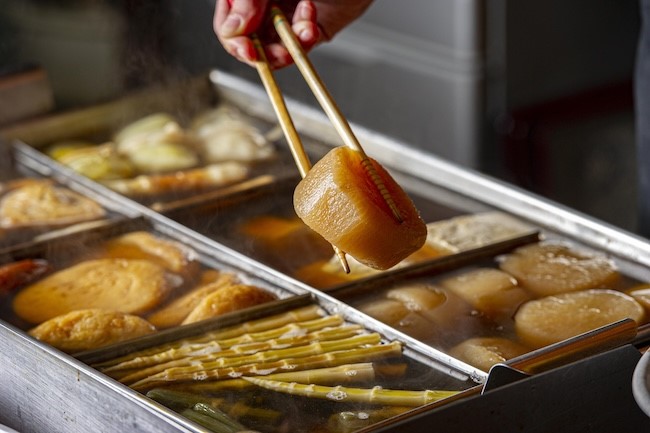
Kanto-style Oden (Eastern Japan)
This is the most commonly recognized version of oden, especially in Tokyo. The broth is made from soy sauce, giving it a dark color. It has a strong and savory flavor. One unique ingredient commonly found in Kanto-style Oden is ganmodoki, a tofu-based cake made with vegetables.
Kansai-style Oden (Osaka area)
The broth is lighter in comparison to the Kanto version. Instead of stewing the ingredients in the broth for a long time, they are added just before serving, keeping the original flavors of the ingredients. It features a wide range of ingredients, including tofu, daikon radish, and grilled mochi rice cakes. One of the highlights of Kansai-style Oden is the use of kushikatsu, skewered and deep-fried ingredients that are then simmered in the broth.
Nagoya-style Oden
Also known as "Miso Oden," this version uses red miso for the broth, giving it a distinctly different flavor and reddish-brown color. Ingredients like miso-kushi (skewered ingredients covered with miso) are popular in this style in Nagoya.
Kyushu-style Oden (Southern Japan)
The broth has a distinct tonkotsu (pork bone) base, which is typical of Kyushu, especially Fukuoka.
Hiroshima-style Oden
The broth has a unique flavor from using seaweed and dried bonito. Ingredients like birodo, a type of fish cake, are characteristic of this region Hiroshima.
Shizuoka-style Oden
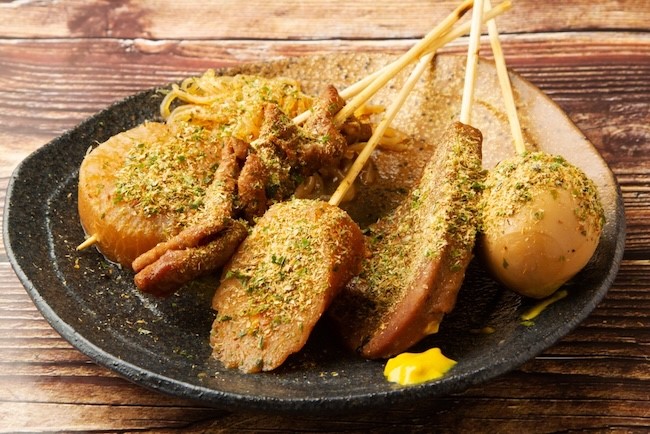
Known for using dark soy sauce, resulting in a blackish broth. It also has unique ingredients like black hanpen (a type of fish cake) and beef tendon.
Iwate-style Oden
This version is known as "Daiji Oden," which features ingredients like abura-age (fried tofu) stuffed with mochi (rice cake).
Kanazawa-style Oden
This version is famous for using yellowtail fish in the broth.
Savoring Oden: A Social Experience
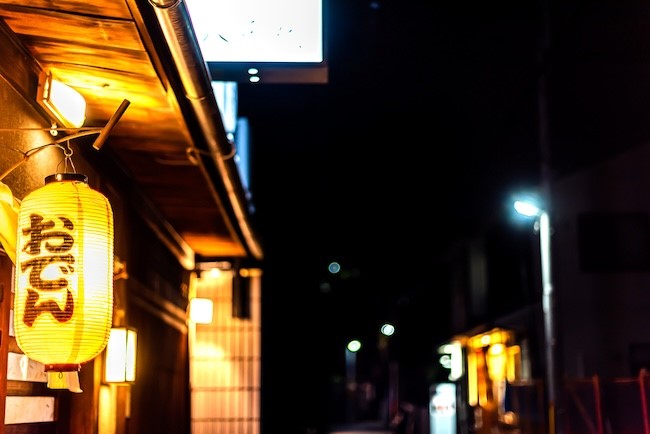
Oden is not just a dish for the Japanese; it's a tradition, a socio-cultural phenomenon that brings people together and fosters a sense of unity and companionship. One can only fully appreciate Oden by immersing oneself in the restaurant and street-stall culture of Japan, as well as the intimate home-based traditions centered around this culinary marvel.
Street-Stall Culture
Imagine a chilly night in Tokyo. As you wander the city's labyrinth of streets and alleyways, a warm, inviting glow cuts through the crisp, cold air. Strange, delicate aromas waft through the night, drawing you in.
Here, you'll find yatai — mobile street food carts — lining the streets, promising a hot, comforting bowl of Oden. Strangers huddle around these bustling stalls, finding solace in the warmth of the simmering pot and each other's company. As you pull up a stool, order a dish and share hearty laughter, you're no longer a mere traveler. You become a part of the city's pulsating urban fabric. This isn't just street food — it's an iconic urban ritual with Oden at its heart.
Oden at Izakayas & Homes
While street stalls paint one picture of the Oden experience, Izakayas — Japanese pubs — and homes showcase a different facet altogether.
In an Izakaya, amidst a spread of tempting dishes, you can often spot a large, bubbling pot of Oden. The Izakaya's warm, enveloping ambiance elevates the Oden experience, turning each bite into a comforting relief. Sharing an Oden pot at an Izakaya often leads to camaraderie and bonding as the dish slowly cooks and the night stretches out.
Similarly, at a Japanese home, Oden often holds center stage during winter gatherings. As family and friends cluster around the warmth of the Oden pot, the slow-cooked dish works its magic, bringing hearts closer. The precious moments of watching the ingredients gently simmer, the laughter echoing off the walls, and the final unveiling of the flavorful Oden — it's an experience that transcends the act of communal eating.
Oden as a Winter Dish
Traditionally, Oden is a winter staple in Japan. In the biting cold, a hot bowl of Oden feels nothing short of a warm hug. Each ingredient, having soaked in the savory broth for hours, bursts with comforting flavors, providing warmth from the inside. Interestingly, Oden is a unique offering as it's loved hot from the pot as much as it's enjoyed at room temperature, making it an all-weather star.
Oden can be compared to a campfire, not just because it keeps you warm during frosty winter nights, but more for its unique ability to bring people closer around it. Whether it's at a bustling street stall, an inviting izakaya, or in cozy homes, Oden not only satiates hunger but also feeds the soul, making its enjoyment a profoundly social, almost ceremonial experience.
Embracing the Warmth of Oden
Japanese Oden encapsulates a rich culinary tradition, evolving over centuries to offer a comforting bowl of warmth. Its regional variations highlight the diversity and creativity inherent in Japanese cuisine. From bustling street stalls and lively izakayas to intimate family gatherings, Oden transcends being a mere dish to becoming a cherished social experience. As the cold winds herald the arrival of autumn and winter, a simmering pot of Oden awaits to warm our hearts and foster camaraderie.
Have we got your appetite going? Find more content on Japanese cuisine in our plethora of other articles.
